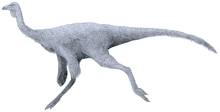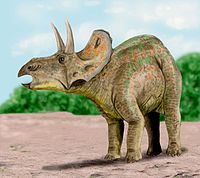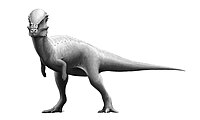| Lance Formation | |
|---|---|
| Stratigraphic range: Maastrichtian ~69–66 Ma PreꞒ Ꞓ O S D C P T J K Pg N ↓ | |
 Badlands in the Lance Formation along Cow Creek near the type locality, Niobrara County, Wyoming Badlands in the Lance Formation along Cow Creek near the type locality, Niobrara County, Wyoming | |
| Type | Sedimentary |
| Underlies | Fort Union Formation |
| Overlies | Meeteetse Formation |
| Thickness | up to 600 metres (1,970 ft) |
| Lithology | |
| Primary | Sandstone, siltstone, shale |
| Location | |
| Region | Wyoming |
| Country | United States |
| Type section | |
| Named for | Lance Creek, Wyoming |

The Lance (Creek) Formation is a division of Late Cretaceous (dating to about 69–66 Ma) rocks in the western United States. Named after Lance Creek, Wyoming, the microvertebrate fossils and dinosaurs represent important components of the latest Mesozoic vertebrate faunas. The Lance Formation is Late Maastrichtian in age (Lancian land mammal age), and shares much fauna with the Hell Creek Formation of Montana and North Dakota, the Frenchman Formation of southwest Saskatchewan, and the lower part of the Scollard Formation of Alberta.
The Lance Formation occurs above the Baculites clinolobatus ammonite marine zone in Wyoming, the top of which has been dated to about 69 million years ago, and extends to the K-Pg boundary, 66 million years ago. However, the characteristic land vertebrate fauna of the Lancian age (which take its name from this formation) is only found in the upper strata of the Lance, roughly corresponding to the thinner equivalent formations such as the Hell Creek Formation, the base of which has been estimated at 66.8 million years old.
Description
The formation is described by W.G. Pierce as thick-bedded, buff-colored sandstone, and drab to green shale. It is Upper Cretaceous in age.
The formation varies in thickness from about 90 m (300 ft.) in North Dakota, to almost 600 m (2,000 ft.) in parts of Wyoming.
Depositional environment
The Lance Formation was laid down by streams, on a coastal plain along the edge of the Western Interior Seaway. The climate was subtropical; there was no cold season and probably ample precipitation.
Paleontology
At least tens of thousands of Late Cretaceous vertebrate remains have been recovered from the Lance Formation. Fossils ranging from microscopic elements to extensive bonebeds, with nearly complete, sometimes articulated dinosaur skeletons, have been found. Most other animals known from the formation are freshwater animals, and some are exclusively freshwater forms (for instance, frogs and salamanders). However, marine fossils are also found in the formation, suggesting that the sea was nearby. The bird fauna is mainly composed of orders still existing today.
Coelurosaurs
Color key
|
Notes Uncertain or tentative taxa are in small text; |
Birds
| Birds reported from the Lance Formation | ||||||
|---|---|---|---|---|---|---|
| Genus | Species | Location | Stratigraphic Position | Material | Notes | Images |
|
A. retusus |
Reclassified as Palintropus retusus |
|||||
|
C. major |
|
A possible charadriiform bird | ||||
|
C. petra |
Reclassified as Lamarqueavis minima | |||||
|
C. rara |
|
A charadriiform | ||||
|
C. retusa |
Reclassified as Palintropus retusus | |||||
|
C. minima |
Reclassified as Lamarqueavis minima | |||||
|
"Cimolopteryx" |
"C." maxima |
|
A charadriiform bird, not necessarily closely related to Cimolopteryx. | |||
|
G. augustus |
|
A possible charadriiform | ||||
|
L. minima |
|
A charadriiform | ||||
|
L. petra |
|
A charadriiform | ||||
|
L. estesi |
|
A possible procellariiform | ||||
|
"Lonchodytes" |
"L." pterygius |
|
A possible charadriiform | |||
|
"P." vetus |
|
A bird similar to gruids, idiornithids and presbyornithids. | ||||
|
P. retusus |
|
A basal ornithuromorph belonging to Ambiortiformes. | ||||
|
P. skutchi |
|
A hesperornithiform possibly also present in the Hell Creek Formation. | ||||
|
T. clemensi |
|
A possible pelecaniform | ||||
|
Unnamed presbyornithid |
Indeterminate |
|
||||
|
Unnamed enantiornithean |
Unnamed |
|
An enantiornithean, previously referred to "Ornithomimus" minutus | |||
|
Unnamed avian |
Indeterminate |
|
An indeterminate avian | |||
|
Unnamed phalacrocoracid |
Indeterminate |
|
A possible phalacrocoracid | |||
|
Unnamed galloanserine |
Indeterminate |
|
A possible galloanserine | |||
|
"Unnamed ornithurine A" |
Indeterminate |
|
Originally thought to belong to Cimolopteryx rara, but probably a new species. Also present in the Frenchman Formation. | |||
|
"Unnamed ornithurine C" |
Indeterminate |
|
Also present in the Hell Creek Formation. | |||
|
"Unnamed ornithurine E" |
Indeterminate |
|
Also present in the Hell Creek Formation. | |||
|
"Unnamed ornithurine F" |
Indeterminate |
|
Originally thought to belong to "Cimolopteryx" maxima, but probably a new species. | |||
Other coelurosaurs
An isolated tooth crown of an indeterminate coelurosaur is recovered from the formation.
| Miscellaneous coelurosaurs of the Lance Formation | ||||||
|---|---|---|---|---|---|---|
| Genus | Species | Location | Stratigraphic Position | Material | Notes | Images |
|
A. amplus |
Teeth, type specimen |
Dubious tyrannosaurids probably synonymous with Tyrannosaurus rex |
   | |||
|
A. cristatus |
Teeth, type specimen | |||||
|
"O." sedens |
"Sacrum and fragmentary illium" type specimen |
An ornithomimid. | ||||
|
P. caperatus |
Teeth, type specimen |
A troodontid | ||||
|
P. bakkeri |
Teeth, type specimen |
|||||
|
T. rex |
Several partial specimens and teeth |
A tyrannosaurid originally identified from the Hell Creek Formation. Also found in the Denver, Ferris, Frenchman, Javelina, Livingston, McRae, North Horn, Scollard, and Willow Creek Formations. Synonyms with type specimens from this formation include Dynamosaurus imperiosus and Manospondylus gigas. | ||||
| Nanotyrannus | N. lancensis | Synonym of Tyrannosaurus. | ||||
| Trierarchuncus | cf. T. prairiensis |
|
An alvarezsaurid originally identified from the Hell Creek Formation. | |||
| Caenagnathidae | Indeterminate | UCMP 143274 | Previously identified as a parrot | |||
| Troodontinae | Indeterminate | YPM VP 004691 | Not referrable to Paronychodon or Pectinodon. | |||
| cf. Microraptoria | Indeterminate |
|
Potentially the youngest microraptorian specimens, but YPM VP 865 may belong to the Unenlagiinae or Halszkaraptorinae. | |||
| Eudromaeosauria | Indeterminate | YPM VPPU 20589 | ||||
Ornithischia
Ankylosaurs
| Ankylosaurs of the Lance Formation | ||||||
|---|---|---|---|---|---|---|
| Genus | Species | Location | Stratigraphic Position | Material | Notes | Images |
|
A. magniventris |
|
More than 70 osteoderms and a tooth |
An ankylosaurid, originally identified from the Hell Creek Formation. |
   | ||
|
D. schlessmani |
|
A nearly complete skull, several teeth and osteoderms. |
||||
|
E. sp. |
|
Teeth |
A nodosaurid. Fossils have been unearthed in the Hell Creek Formation, the Ferris Formation, the Dinosaur Park Formation, the Horseshoe Canyon Formation, and the Denver Formation. | |||
|
"P. latus" |
|
Teeth |
Probably a nodosaurid, but the teeth could also belong to the Pachycephalosauridae. | |||
Marginocephalians
| Marginocephalians reported from the Lance Formation | ||||||
|---|---|---|---|---|---|---|
| Genus | Species | Location | Stratigraphic Position | Material | Notes | Images |
|
A. sylvestris |
"Partial sacrum and pelvis," type specimen. |
A dubious ceratopsid probably synonymous with Triceratops horridus |
      | |||
|
L. gracilis |
A ceratopsian | |||||
|
N. hatcheri |
" skull," type specimen. |
A ceratopsid possibly synonymous with Triceratops horridus. Synonyms include Diceratops hatcheri and Diceratus hatcheri. | ||||
|
P. wyomingensis |
Fragmentary specimens including the type specimen. |
A pachycephalosaur. Synonyms with type specimens from this formation include Troodon wyomingensis. | ||||
|
"Palaeoscincus" |
"P." latus |
"Tooth." |
A dubious pachycephalosaur, previously classified as the ankylosaur Palaeoscincus | |||
|
S. spinifer |
A pachycephalosaur possibly synonymous with Pachycephalosaurus wyomingensis | |||||
|
T. latus |
Several specimens including the type specimen. |
A ceratopsid possibly synonymous with Triceratops horridus. Torosaurus gladius, with type specimen from this formation, is a synonym. Also present in the Frenchman and Hell Creek Formations. | ||||
|
T. horridus |
"Partial skull and skeleton," type specimen |
A ceratopsid, also found in the Evanston, Frenchman, Hell Creek, Laramie, and Scollard Formations. Synonyms with type specimens from this formation include T. ingens and T. sulcatus. | ||||
| T. sp. | ||||||
Ornithopods
Indeterminate lambeosaurinae fossils have been found in the Lance Formation.
| Ornithopods of the Lance Formation | ||||||
|---|---|---|---|---|---|---|
| Genus | Species | Location | Stratigraphic Position | Abundance | Notes | Images |
|
E. annectens |
Skull, skeletons, including the type specimen, "mummy", and a bone bed. |
A hadrosaurid. Synonyms from this formation include Anatosaurus annectens and Claosaurus annectens. Also found in the Frenchman, Hell Creek, Laramie and Scollard Formations. |
  | |||
|
T. neglectus |
Well-preserved skeleton, type specimen |
A thescelosaurid. Also found in the Frenchman, Hell Creek, Laramie and Scollard Formations. | ||||
|
T. occidentalis |
Teeth, vertebrae, toe bone (including type specimen) |
A dubious hadrosaurid possibly synonymous with E. annectens | ||||
|
"T." longiceps |
One partial jaw (YPM 616), type specimen |
A dubious hadrosaurid possibly synonymous with E. annectens | ||||
Other vertebrates
Other land vertebrates include pterosaurs (e.g. cf. Azhdarcho), crocodiles, champsosaurs, lizards, snakes, turtles, frogs and salamanders.
Remains of fishes and mammals (i.e. Nanocuris) have also been found in the Lance Formation.
See also
- List of fossil sites (with link directory)
- List of dinosaur-bearing rock formations
References
- Lehman, T. M., Mcdowell, F. W., & Connelly, J. N. (2006). First isotopic (U-Pb) age for the Late Cretaceous Alamosaurus vertebrate fauna of West Texas, and its significance as a link between two faunal provinces. Journal of Vertebrate Paleontology, 26(4), 922–928.
- Pierce, W.G., 1997, Geologic map of the Cody 1 degree x 2 degrees quadrangle, northwestern Wyoming: U.S. Geological Survey, Miscellaneous Geologic Investigations Map I-2500, scale 1:250000.
- Silver, Mark (August 2, 2014) "The Dinosaur Surveyors" The American Surveyor Frederick Maryland
- ^ Nicholas R. Longrich (2011). "Titanoceratops ouranous, a giant horned dinosaur from the Late Campanian of New Mexico". Cretaceous Research. 32 (3): 264–276. doi:10.1016/j.cretres.2010.12.007.
- ^ Federico L. Agnolin (2010). "An avian coracoid from the Upper Cretaceous of Patagonia, Argentina". Stvdia Geologica Salmanticensia. 46 (2): 99–119. ISSN 0211-8327. S2CID 54675909.
- ^ Hope, S. (2002). "The Mesozoic radiation of Neornithes". In Chiappe, L.M.; Witmer, L.W. (eds.). Mesozoic Birds: Above the Heads of Dinosaurs. Berkeley: University of California Press. pp. 339–388. ISBN 978-0520200944.
- ^ Longrich, N. 2009. An ornithurine-dominated avifauna from the Belly River Group (Campanian, Upper Cretaceous) of Alberta, Canada. Cretaceous Research, 30(1): 161–177.
- ^ Elzanowski, Paul and Stidham, 2001. An avian quadrate from the Late Cretaceous Lance Formation of Wyoming. Journal of Vertebrate Paleontology, 20(4): 712–719.
- "Table 11.1," in Weishampel, et al. (2004). Page 215.
- Olson, S.L. and Feduccia, A. 1980. Presbyornis and the origin of the Anseriformes (Aves: Charadriomorphae). Smithsonian Contributions to Paleobiology no. 323.
- ^ Chiappe, L.M.; Walker, C.A. (2002). "Skeletal morphology and systematics of the Cretaceous Euenantiornithes (Ornithothoraces: Enantiornithes)". Mesozoic Birds, above the heads of Dinosaurs. Berkeley: University of California Press. pp. 240–267. ISBN 978-0520200944.
- ^ Elzanowski, A.; Stidham, T.A. (2011). "A Galloanserine Quadrate from the Late Cretaceous Lance Formation of Wyoming". The Auk. 128 (1): 138–145. doi:10.1525/auk.2011.10113.
- ^ Brownstein, C. D. (2024). "A juvenile bird with possible crown-group affinities from a dinosaur-rich Cretaceous ecosystem in North America". BMC Ecology and Evolution. 24 (1). 20. Bibcode:2024BMCEE..24...20B. doi:10.1186/s12862-024-02210-9. PMC 10858573. PMID 38336630.
- "Table 6.1," in Weishampel, et al. (2004). Page 139.
- Dalman, Sebastian (October 2013). "New Examples of Tyrannosaurus rex from the Lance Formation of Wyoming, United States". Bulletin of the Peabody Museum of Natural History. 54 (2): 241–254. doi:10.3374/014.054.0202. S2CID 128608668. Retrieved 16 November 2020.
- Dyke, G. J.; Mayr, G. (1999). "Did parrots exist in the Cretaceous period?". Nature. 399 (6734): 317–318. Bibcode:1999Natur.399..317D. doi:10.1038/20583. S2CID 204993284.
- Waterhouse, D. M. (2006). "Parrots in a nutshell: The fossil record of Psittaciformes (Aves)". Historical Biology. 18 (2): 227–238. Bibcode:2006HBio...18..227W. doi:10.1080/08912960600641224. S2CID 83664072.
- Stidham, T. (1998). "A lower jaw from a Cretaceous parrot" (PDF). Nature. 396 (6706): 29–30. Bibcode:1998Natur.396...29S. doi:10.1038/23841. S2CID 204995638.
- The Dinosauria 2nd Edition (David B. Weishampel, Halszka Osmólska and Peter Dodson), p. 584, Dinosaur Distribution (DAVID B. WEISHAMPEL, PAUL M. BARRETT, RODOLFO A. CORIA, JEAN LE LOEUFF, XU XING, ZHAO XIJIN, ASHOK SAHNI, ELIZABETH M. P. GOMANI, CHRISTOPHER R. NOTO)
- Bakker, R.T. (1988). Review of the Late Cretaceous nodosauroid Dinosauria: Denversaurus schlessmani, a new armor-plated dinosaur from the Latest Cretaceous of South Dakota, the last survivor of the nodosaurians, with comments on Stegosaur-Nodosaur relationships. Hunteria 1(3):1–23.(1988).
- ^ The Dinosauria 2nd Edition (David B. Weishampel, Halszka Osmólska and Peter Dodson), p. 585, Dinosaur Distribution (DAVID B. WEISHAMPEL, PAUL M. BARRETT, RODOLFO A. CORIA, JEAN LE LOEUFF, XU XING, ZHAO XIJIN, ASHOK SAHNI, ELIZABETH M. P. GOMANI, CHRISTOPHER R. NOTO)
- Lyson, Tyler R.; Longrich, Nicholas R. (22 April 2011). "Spatial niche partitioning in dinosaurs from the latest cretaceous (Maastrichtian) of North America". Proceedings of the Royal Society B: Biological Sciences. 278 (1709): 1158–1164. doi:10.1098/rspb.2010.1444. PMC 3049066. PMID 20943689.
- Carpenter, Kenneth; Young, D. Bruce (1 January 2002). "Late Cretaceous dinosaurs from the Denver Basin, Colorado". Rocky Mountain Geology. 37 (2): 237–254. doi:10.2113/11. Retrieved 19 November 2020.
- Lillegraven, Jason A.; Eberle, Jaelyn J. (July 1999). "Vertebrate faunal changes through Lancian and Puercan time in southern Wyoming". Journal of Paleontology. 73 (4). Cambridge University Press: 691–710. doi:10.1017/S0022336000032510. S2CID 133072078.
- Dale A. Russel; Makoto Manabe (2002). "Synopsis of the Hell Creek (uppermost Cretaceous) dinosaur assemblage". In Nichols, Douglas J.; Hartman, Joseph Herbert; Johnson, Kirk R. (eds.). The Hell Creek Formation and the Cretaceous-Tertiary Boundary in the Northern Great Plains: An Integrated Continental Record of the End of the Cretaceous · Issue 361. Geological Society of America. p. 170. ISBN 9780813723617. Retrieved 19 November 2020.
- Carpenter, Kenneth; Breithaupt, Brent (September 2, 1986). "Latest Cretaceous Occurrence of Nodosaurid Ankylosaurs (Dinosauria, Ornithischia) in Western North America and the Gradual Extinction of the Dinosaurs". Journal of Vertebrate Paleontology. 6 (3). Taylor & Francis, Ltd.: 251–257. doi:10.1080/02724634.1986.10011619. JSTOR 4523098. Retrieved 24 April 2021.
- ^ "Table 17.1," in Weishampel, et al. (2004). Page 368.
- ^ "Table 23.1," in Weishampel, et al. (2004). Page 496.
- ^ Scannella, J. and Horner, J.R. (2010). "Torosaurus Marsh, 1891, is Triceratops Marsh, 1889 (Ceratopsidae: Chasmosaurinae): synonymy through ontogeny." Journal of Vertebrate Paleontology, 30(4): 1157 – 1168. doi:10.1080/02724634.2010.483632
- Horner J.R. and Goodwin, M.B. (2009). "Extreme cranial ontogeny in the Upper Cretaceous Dinosaur Pachycephalosaurus." PLoS ONE, 4(10): e7626. Online full text
- Wegweiser, M.; Breithaupt, B.; Badcock, L. E.; Skinner, E.; Scheffield, J. (January 2003). "DINOSAUR SKIN FOSSILS FROM THIS SIDE OF HELL, WYOMING: PALEOENVIRONMENTAL IMPLICATIONS OF AN UPPER CRETACEOUS KONSERVAT-LAGERSTATTE IN THE LANCE FORMATION". Journal of Vertebrate Paleontology. 23: 108A.
- Snyder, Keith; McLain, Matthew; Wood, Jared; Chadwick, Arthur (2020-05-21). "Over 13,000 elements from a single bonebed help elucidate disarticulation and transport of an Edmontosaurusthanatocoenosis". PLOS ONE. 15 (5): e0233182. Bibcode:2020PLoSO..1533182S. doi:10.1371/journal.pone.0233182. ISSN 1932-6203. PMC 7241792. PMID 32437394.
- Boyd, Clint A.; Brown, Caleb M.; Scheetz, Rodney D.; Clarke, Julia A. (2009). "Taxonomic revision of the basal neornithischian taxa Thescelosaurus and Bugenasaura". Journal of Vertebrate Paleontology. 29 (3): 758–770. doi:10.1671/039.029.0328. S2CID 84273584.